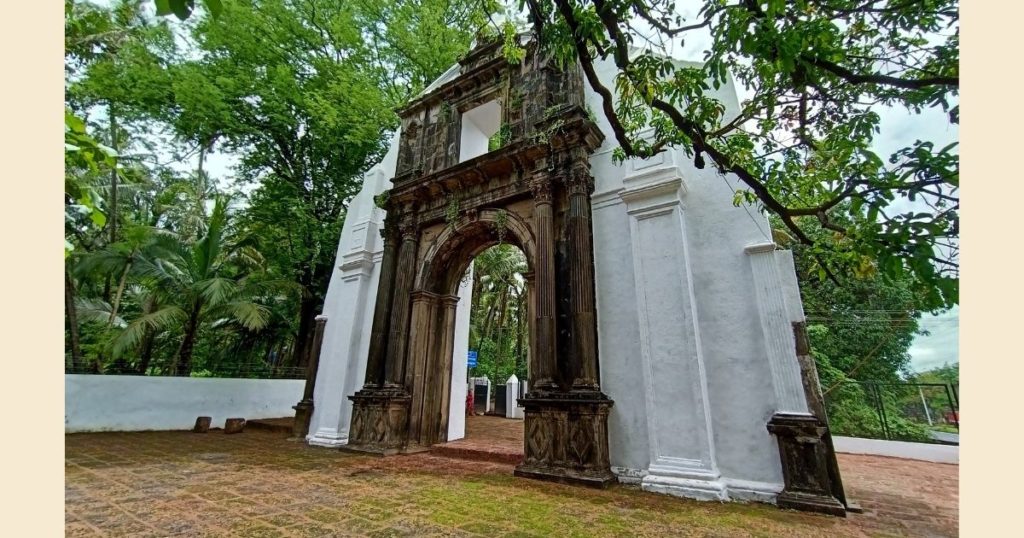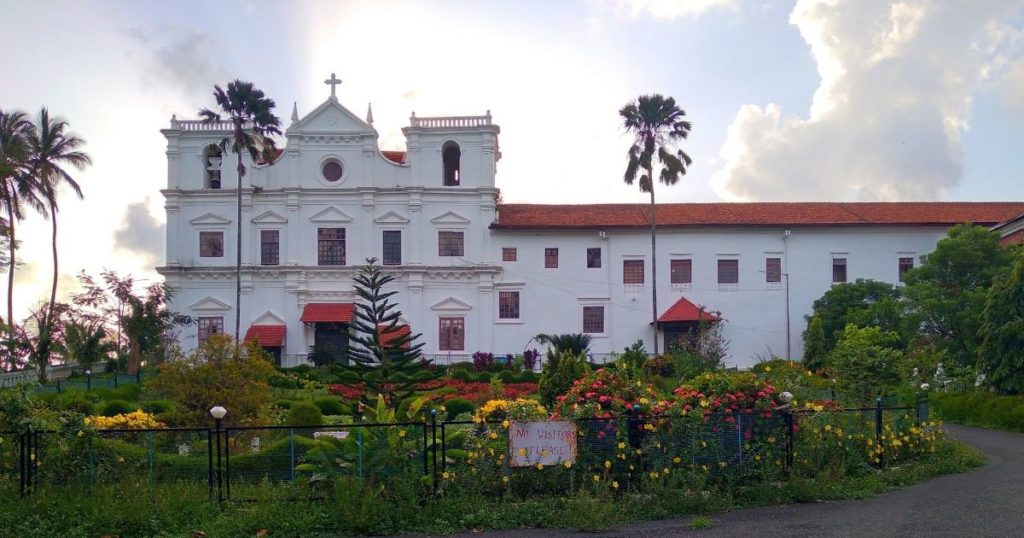The Story of Goa and Print
Author
Annalie Gracias

The history of modern-day print in the Indian subcontinent can be traced to a serendipitous incident four centuries ago, off the coast of India’s smallest state, Goa.
The year was 1556. A ship carrying a printing press from Portugal to Abyssinia (Ethiopia) to aid missionary activity there1, stopped en route in Goa, the capital of Estado Português da Índia (Portuguese State of India). While there, word arrived that relations with the Abyssinian ruler had deteriorated to an extent. Thus, the printing press was unloaded on Goan shores and set up at the College of St Paul, the continent’s leading Jesuit institution at the time.
This was the first printing press in all of Asia.
The College of St Paul: Where it all began
The first Jesuit to set foot on Goan soil was St Francis Xavier in 1542, co-founder of the Society of Jesus (the Jesuit order) with St Ignatius of Loyola. While in Goa, St Xavier headed the College of St Paul (Colégio de São Paulo) situated in the current Old Goa, where the first printing press was installed four years after his death.
João de Bustamante, considered the ‘Indian Gutenberg’2, was a Spaniard skilled in printing who travelled from Portugal along with the printing press. He helped install the printing press at the College and is credited with printing the earliest books in the subcontinent. It is said that Bustamente was assisted in the establishment of the printing press by a person of Indian origin, who also arrived from Portugual but remains unnamed in historical documents, only referred to as ‘Habil Impressor’ (an able printer).3
The first materials to be printed were ‘conclusões’ (theses) on logic and philosophy for the express purpose of a spirited debate on these theses. They were also stuck to the doors of the Church of St Paul before the discussion to allow friars to read them. It is unestablished whether these printed ‘conclusões’ were in the form of loose pages or booklets. Based on this, the first printed book is believed to be St Francis Xavier’s Catecismo da Doutrina Christa, published in 1557 in Portuguese.4
The oldest printed book in the subcontinent with a copy still in existence is Gaspar De Leão’s Compendio Spiritual Da Vida Christãa (Spiritual Compendium of the Christian Life) published in 1561 at the College. Today, one will have to visit the New York Public Library to view the copy.
The first book to be printed in the subcontinent in a vernacular language and script was a Tamil version of Doutrina Christa, published at a press in Quilon (Kollam) on the Malabar Coast in 1578. Titled ‘Thambiran Vanakkam’, this prayer book was authored by Portuguese missionary Henrique Henriques and was 16 pages in length.5
Tamil is also considered to be the first non-European language to come through the mechanised printing press. Two years before the very advent of printing in the subcontinent”, ‘Cartilha em Tamul e Portugues’ (Christian Cathechism in Tamil and Portuguese) was published in Lisbon, a bilingual book in the Roman script. The translation was done by three Tamil Christians from Lisbon – Vincente de Nazareth, Thome da Cruz and Jorge Carvalho – and headed by Father Joao Villa de Conde. The sole copy still in existence can be found at the National Museum of Ethnology near Belem in Lisbon.6

Rachol Seminary: The birthplace of printed Konkani literature
“Sisters and Brothers of America,” Swami Vivekananda began his address at the 1893 Parliament of the World’s Religions in Chicago – one that received a thunderous standing ovation from the 7,000 attendees and continues to resonate in speeches till today. A year before the speech that enthralled America, Swami Vivekananda is said to have visited the Patriarchal Seminary of Rachol, a diocesan seminary (among the first seminaries in Goa) situated on a hillock in the quaint village of Rachol, to gain a better understanding of Christian theology in preparation for his visit to Chicago.
Rachol played a prominent role in the early days of print in the subcontinent. The printing press here was set up at the College of All Saints, later renamed the College of St Ignatius, where Rachol Seminary is currently located. The first book was printed in 1616; Krista Purana by Jesuit priest Thomas Stephens, who is believed to be the first Englishman to set foot in Indian subcontinent.
A founding father of Konkani literature, Stephens however is most recognised for this work – an epic poem that tells the story of the Bible (both Old and New Testament)7 in Marathi.
‘Kristapurana may be read as one of the first retellings of the biblical narrative into a South Asian language. . . Puranas were originally Sanskrit texts, held in reverence by various sects of Hindus in the Indian subcontinent. In the period between 1000 CE and 1500 CE, these Sanskrit texts began to travel to the regional languages of the subcontinent through translations, including Marathi. Marathi literary scholars place Kristapurana in this tradition of Marathi Puranas’, writes Annie Rachel Royson, in an online essay titled ‘Kristapurana: An Introduction’.
Stephens is also credited as the author of the first printed grammar in an Indian language through his Arte da Lingoa Canarim (Grammar of Canarim language), which was revised and printed in 1640 by his student Fr Diogo Ribeiro and other Jesuits. Its purpose was to help missionaries learn the Canarim language to help them evangelise the villages of Salcete.8 Canarim is an old term for the language that is presently spoken across the length and breadth of Goa, Konkani.
The first-ever Konkani book to be printed was also authored by Thomas Stephens – Doutrina Christam em Lingoa Bramana Canarim, published at Rachol in 1622. Copies of this work can be found at the National Library in Lisbon and the Vatican Library in Rome.9

Stephens was a staunch advocate for the printing of books in the script of the people – Devanagri. However, it is supposed that the sheer number of types required to be cast made it appear inconceivable and it required the approval of the Provincial.10 Thus, while books appeared in local languages of Goa, the Roman script was used in their publication.
The printing press at Rachol ran for more than five decades till 1674 and contributed to a trove of published literature.
A harsh blow to printing in Goa came through the 1684 order which sought to extinguish Konkani among the local populace and compulsorily replace it with Portuguese in three years. Less than a century later, the Jesuits were also imprisoned and removed from Goa, following a decree by the King of Portugal in 1759 expelling the Society of Jesus from Portugal. Printing in Goa was revived only in 1821 with a periodical known as Gazeta de Goa.
Present Day: Preserving the Past for Posterity
Stepping into the Rare Book Section at the Krishnadas Shama Goa State Central Library in Panaji gives you a glimpse into the literary days of yore. Among the oldest public libraries in the country, its Rare Book Section is home to a rich repository of literature in diverse languages such as Konkani, Portuguese, Latin, Sinhalese, Tamil, and Castilian dating back to the sixteenth century. The oldest book there is Ubaldis’ Sexto Super Codices Justinian Commentari, Lugdini, published in 1539. The collection also houses books from the initial days of print in Goa with the earliest published in 1643.11 A handwritten manuscript of the Kristapurana can be found here, copied from an earlier edition by Manoel Salvador Rebello in 1767.12
There’s also a preservation laboratory within its premises with a systematic conservation process in place. The section head identifies books in need of preservation which are subsequently sent to the data imaging centre to be scanned. An overhead scanner generates a digital replica of each page in mere seconds while ensuring that these aged tomes need not be flipped over thus protecting them from damage.
Inside the book conservation laboratory, each page is painstakingly preserved with the application of Japanese tissue (similar to a thin translucent sheet) on both sides. The tissue is transparent and protects the page underneath for at least a century. Plus, the process is reversible. Remove the Japanese tissue and the page will still be in its original condition. Certain manuscripts are also wrapped in insect-repellent cloth and showcased in glass cases.
Acknowl-edging History: Tracing the Trail of Time
The desire of Portuguese missionaries to spread Christianity in the subcontinent brought us the earliest works of print in the region.
Goa, the smallest state in India is one with the longest history of colonialism, lasting from 1510 to 1962. The resulting amalgam of Indo-Portuguese influence is seen from the very first printing press – with the Roman script (of Portuguese type) used to print works in vernacular languages. The absence of Devanagri moulds for printing Konkani in the local script could be credited with shaping the foundation of Romi Konkani. Widely used across Goa today, this script has its origin in the writings of Thomas Stephens.
Just how the simple flap of a butterfly’s wings in New Mexico might cause a storm in China, history too weaves indelible threads to the present.
References
1 Chehak Bansal, “History of Printing Press in India”, Osmo Magazine, 8 February 2021, osmomag.com/history/history-of-printing-press-in-india
2 Wikipedia contributors, “João de Bustamante”, Wikipedia, 9 February 2020, https://en.wikipedia.org/wiki/Jo%C3%A3o_de_Bustamante
3 Anant Kakba Priolkar, The Printing Press in India: Its Beginnings and Early Development (Bombay: Marathi Samshodhana Mandala, 1958).
4 Anant Kakba Priolkar, The Printing Press in India: Its Beginnings and Early Development.
5 K Madhavan, “Tamil saw its first book in 1578”, The Hindu, 21 June 2010, https://www.thehindu.com/news/national/tamil-nadu/Tamil-saw-its-first-book-in-1578/article15685475.ece
6 A Limited, “English: A page from Luso-Tamil Catechism (Cartilha or Primer) printed in Lisbon in 1554 CE”, Alamy, https://www.alamy.com/english-a-page-from-luso-tamil-catechism-cartilha-or-primer-printed-in-lisbon-in-1554-ce-it-is-a-bilingual-work-with-tamil-and-portuguese-phrases-both-printed-in-roman-script-this-is-the-earliest-known-printed-work-of-tamil-though-in-roman-script-the-books-is-38-pages-long-with-tamil-phrases-in-red-followed-immediately-by-portuguese-translations-printed-in-black-in-smaller-font-authors-of-the-book-were-tamil-christians-living-in-lisbon-vincente-de-nazareth-thome-da-cruz-and-jorge-carvalho-they-were-supervised-by-father-joao-villa-de-conde-the-single-surviving-copy-of-the-image351998744.html
7 Annie Royson, “Kristapurana: An Introduction”, Sahapedia, 2019, www.sahapedia.org/kristapurana-introduction
8 Ivo Souza, “Evangelisation of the Village of Raia”, ivosouza.wordpress.com/, 2009, https://ivosouza.wordpress.com/2009/01/13/evangelization-of-the-village-of-raia/
9 Mousinho de Ataide, Rachol (Goa: New Age Printers, 2012).
10 Anant Kakba Priolkar, The Printing Press in India: Its Beginnings and Early Development (Bombay: Marathi Samshodhana Mandala, 1958).
11 Maria Pia De Menezes Rodrigues, Texts, Tomes and Treasures – The Evolution of Goa’s Publica Livraria (1832 – 2005) (Goa: 2014).
12 Annie Royson, “Kristapurana: An Introduction”.
About the Author
Annalie Gracias is a freelance journalist and copyeditor based in Goa, India. She has served as the Assistant Editor of Goa Today, the oldest magazine in the state, and was also awarded a scholarship for the Australian Digital Job Accelerator, 2020. She has also been published in gal-dem.com (an independent British online and print publication).
Storytelling is what she does best and her ‘happy place’ is penning words on paper or editing copy to make it read better. She tweets @annaliegracias.

